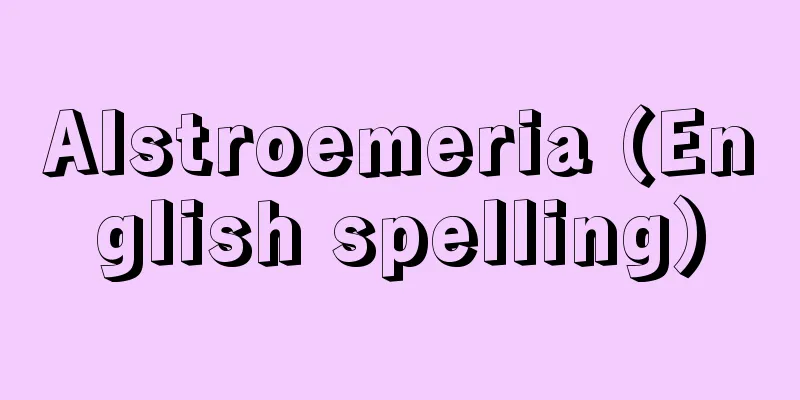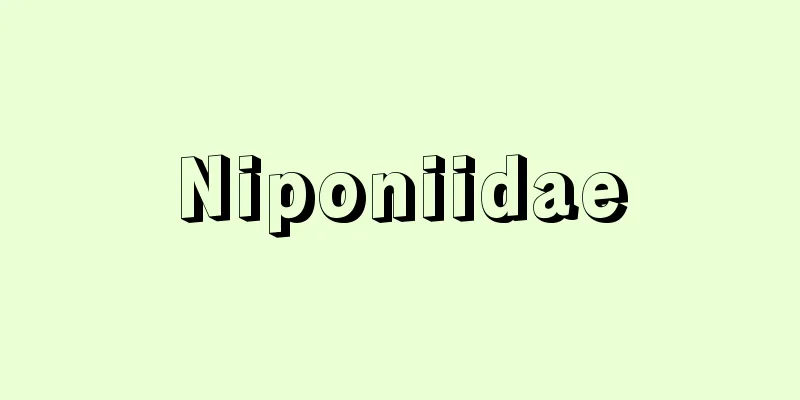Rock crystal

|
Usually, it refers to quartz with a clear crystalline form, but originally it is used to refer to colorless, transparent, flawless crystals. In ancient times, it was believed that quartz was formed by freezing water, and the English name "crystal" comes from the Greek word for ice. [Satoshi Matsubara] Crystal characteristics and occurrenceThe crystal shape is basically a hexagonal column with two types of faces alternating at the ends, forming a hexagonal pyramid shape. Several types of crystal faces may appear at the boundary between the columnar and pyramidal faces. The columnar faces have countless parallel striations developed in the direction perpendicular to the direction of column extension. These striations do not appear on the pyramidal faces. If only one type of pyramidal face is abnormally developed, the ends will appear triangular. In terms of crystal structure, although it has an axis of symmetry, it does not have a plane or center of symmetry. However, there are crystals that form pairs like the relationship between a right hand and a left hand (the relationship between the real thing and its image in a mirror), and they are divided into right-type (right quartz) and left-type (left quartz). When pressure is applied to quartz from a certain direction, it undergoes dielectric polarization and becomes electrically charged, which is why it is used in quartz oscillators and other devices. It is also used in optical prisms, but there are few natural crystals that are colorless, transparent, and flawless, and large enough for these uses, so today we rely almost entirely on synthetic quartz. Twins are commonly found in quartz. The main types are Dauphine twins (two types: right-handed quartz and left-handed quartz), in which two crystals are joined in a relationship rotated 180 degrees around an axis ( c -axis) parallel to the elongation direction, and Brazilian twins, in which left and right quartz are joined in a reflection relationship parallel to the c- axis. Japanese-style twins, which have been studied in detail as quartz produced in Japan, are two crystals joined at an inclination of 84 degrees and 34 minutes to each other, and often form large, plate-like crystals that are heart-shaped. The ones from the Otome Mine (closed) in Makioka-cho, Yamanashi Prefecture (now Yamanashi City) are world famous. Quartz is a very common crystalline mineral, especially found in quartz veins in granite and in the cavities of granitic pegmatites. It is also found in the cavities of quartz veins in metal veins and metamorphic rocks, and in the cavities of all rocks rich in silica. In Japan, fine crystals are found near Kofu in Yamanashi Prefecture, the Naegi region of Gifu Prefecture, and the Tanakami region of Shiga Prefecture, but are rarely used for industrial or decorative purposes. [Satoshi Matsubara] kindsQuartz has been used as an ornament since ancient times, and is given various names depending on its appearance, as follows: (1) Citrine: Yellow or yellowish brown, transparent. The color is said to be due to fine particles of hydrous ferric oxide dispersed in a colloidal state. Natural production is relatively rare, and it is known in Madagascar and Brazil. Citrine can be easily obtained by heating amethyst or smoky quartz, so it is safe to assume that most citrine (called citrine or citrine topaz) sold in the jewelry market is heat-treated. Natural citrine does not usually have the reddish color of heat-treated amethyst. Care should be taken when polishing citrine, as it is difficult to distinguish it from real topaz (yellow jade; jewelry stores often sell citrine as topaz). (2) Grass-filled Quartz Quartz often contains other minerals. Quartz containing many needle-like or fibrous crystals is sometimes called grass-filled quartz. The most common crystal types are rutile, tourmaline, and amphibole. Quartz containing rutile is often found in Brazil and Madagascar, and is reddish brown or yellow in color. Quartz containing hair-like rutile is called Venus hairstone, and was once popular in Europe. Most of the quartz found in Japan is tourmaline or amphibole, and is often found in Yamanashi Prefecture. Quartz that contains moss-like chlorite and appears green, and quartz with clearly visible liquid inclusions (water-filled quartz) also belong to this group in a broad sense. Also, during crystal growth, tiny other minerals may adhere to the growth surface. If this occurs intermittently, several boundaries become visible within the crystal. This is called mountain-filled quartz, or in English, phantom quartz or ghost quartz. (3) Black quartz: This refers to smoky quartz that is almost completely black and is used as an ornament. It is sometimes called morion. (4) Smoky quartz It ranges from slightly smoky to deep black. Even a single crystal can have a significant difference in color. When heated, the color disappears, but some types of smoky quartz may turn yellowish brown or yellow before the color disappears. Most citrine is created in this way. It is thought that the smoky color is caused by aluminum replacing silicon, which creates defects in the anions and absorbs light. In fact, when radiation is applied to colorless, transparent quartz, it turns smoky, so it is said that natural smoky quartz is formed secondarily from colorless, transparent quartz due to radioactivity. Smoky quartz is mainly found in granitic pegmatites and is found in many places around the world. In Japan, it is often found in the Naegi region of Gifu Prefecture. (5) Pink quartz: This type of quartz is pale pink, pink, or reddish pink in color and is extremely rare. Its color is thought to be due to the substitution of rutile or aluminum. Other gemstones include amethyst, which has been known since ancient times and is the birthstone for February, and is the most expensive type of quartz. [Satoshi Matsubara] "Mountain Crystals: Mineralogy of Quartz" by Mizuhiko Akizuki (1993, Shokabo) [References] | | | | | | | | | | | | | | |Made in Ida, Arkansas, USA ©Masutomi Geological Society Foundation Quartz (rough stone) From the left: Dendritic (grass-containing quartz), different colors, golden quartz, rock crystal (grass-containing) ©Central Gem Laboratory "> crystal ©Central Gem Laboratory "> Amethyst ©Central Gem Laboratory "> Rose Quartz Source: Shogakukan Encyclopedia Nipponica About Encyclopedia Nipponica Information | Legend |
|
普通、結晶形の明瞭(めいりょう)な石英のことをいうが、本来は無色透明で、きずのない結晶に対して使われる。古代においては、水晶は水が凍ってできたものと信じられていたらしく、英名のクリスタルという語は氷を意味するギリシア語に由来している。 [松原 聰] 結晶の特徴と産状結晶形は六角柱状で端は2種類の面が交互に現れる六角錐(すい)状をしているのが基本である。これに何種類かの結晶面が柱面と錐面の境界部に現れることがある。柱面には柱の伸びの方向と垂直の方向に無数の平行な条線が発達している。この条線は錐面には現れない。錐面のうち1種類のみが異常に発達すると、端が三角形にみえる。 結晶構造上、対称軸はもつものの、対称面と対称心がない。しかし、右手と左手の関係(実物と鏡に写った像との関係)のような対をなす結晶が存在し、右型(右水晶)と左型(左水晶)に区別される。水晶はある一定の方向から圧力を加えると、誘電分極をおこして帯電するため、水晶発振器などに利用される。ほかに光学プリズムなどにも使われるが、これらの用途に適する無色透明で、きずのない大型結晶は天然に少なく、現在ではほとんど合成水晶に頼っている。 水晶では双晶が普通にみられる。おもに、伸長方向と平行な軸(c軸)の回りに180度回転した関係で二つの結晶が組み合わさったドフィーネ双晶(右水晶どうし、左水晶どうしの2種類)、左右水晶がc軸と平行に反射の関係で組み合わさったブラジル双晶がある。また、日本産の水晶として詳しく研究された日本式双晶は、2個体が互いに84度34分傾いて結合しているもので、しばしば大きな平板状結晶をしてハート型になる。山梨県牧丘(まきおか)町(現山梨市)の乙女鉱山(閉山)のものが世界的に有名である。 水晶はきわめて普通にみられる結晶鉱物で、とくに花崗岩(かこうがん)中の石英脈、花崗岩質ペグマタイトの空隙(くうげき)によく産する。ほかに、金属鉱脈や変成岩中の石英脈の空隙に、またあらゆるケイ酸分に富む岩石の空隙にみられる。日本では山梨県甲府付近、岐阜県苗木地方、滋賀県田上(たなかみ)地方などで良晶を産するが、工業用や装飾用に利用されることはほとんどない。 [松原 聰] 種類水晶は古代より装飾品として愛用されてきており、外観によっていろいろな名がつけられて次のとおり親しまれている。 (1)黄水晶(きずいしょう)(シトリンcitrine) 黄ないし黄褐色透明なものをいう。色の原因はコロイド状に分散した含水第二酸化鉄の微粒子によるものとされている。天然での産出は比較的まれで、マダガスカル、ブラジルなどに知られる。黄水晶はアメシスト(紫水晶)や煙(けむり)水晶を熱することによって容易に得ることができるため、宝石市場に出ている黄水晶(シトリンあるいはシトリン・トパーズとよんでいる)のほとんどは熱処理品と思って間違いない。天然の黄水晶には、熱処理した紫水晶のような赤みがないのが普通である。研磨したものは、本物のトパーズ(黄玉(おうぎょく)。宝石店ではしばしば黄水晶のことをトパーズと称して売っている)と区別しがたいので注意が必要である。 (2)草入り水晶 水晶にはしばしば他の鉱物が含有されている。このうち、針状ないし繊維状の結晶が多数含有されているものを草入り水晶とよぶことがある。結晶の種類としてはルチル(金紅石)、電気石、角閃石(かくせんせき)がもっとも普通である。ルチル入りのものは、ブラジルやマダガスカルからよく産し、赤褐色ないし黄色を呈する。毛状のルチルが入っているものはビーナスの毛髪石などとよばれ、かつてヨーロッパで人気を得た。日本産のものはほとんど電気石や角閃石であることが多く、山梨県などでよく産出した。ほかにコケのような緑泥石を含んで緑色にみえる水晶や液体包有物がよくみえる水晶(水入り水晶)などは広い意味でこのグループに入る。また、結晶成長の際、微細な他鉱物が成長面上に付着することがある。これが断続的に行われると、結晶内にいくつも境目がみえてくる。これを山入り水晶、英語ではファントム・クォーツ(幻の水晶)あるいはゴースト・クォーツ(幽霊水晶)とよんでいる。 (3)黒水晶 煙水晶のうち、ほとんど真っ黒なものをいい、装飾品とされる。モリオンmorionとよぶことがある。 (4)煙水晶 わずかに煙がかったものから濃い黒色のものまである。また、一つの結晶でも色の濃淡が著しいことがある。熱すると色がなくなるが、ある種の煙水晶では色の消える前に黄褐色ないし黄色になることがある。多くの黄水晶はこうしてつくられたものである。煙色になる原因としては、ケイ素を置換してアルミニウムが入ることにより、陰イオンに欠陥が生じて光を吸収するためと考えられている。また実際放射線を無色透明な水晶に当てると煙色になるところから、天然の煙水晶は放射能によって無色透明な水晶から二次的にできたともいわれている。煙水晶はおもに花崗岩質ペグマタイトから産し、世界的に産地は多い。日本では岐阜県苗木地方によく産出する。 (5)紅水晶 淡桃ないし桃、紅桃色をした水晶で、産出はきわめてまれである。色の原因はルチル(金紅石)やアルミニウムの置換によるものと考えられる。 このほか、古くから知られ2月の誕生石ともなり、水晶中もっとも高価なアメシストなどがある。 [松原 聰] 『秋月瑞彦著『山の結晶――水晶の鉱物学』(1993・裳華房)』 [参照項目] | | | | | | | | | | | | | | |アメリカ アーカンソー州アイダ産©公益財団法人益富地学会館"> 水晶〔原石〕 左からデンドリティック(草入り水晶)、色違い、ゴールデンクォーツ、ロッククリスタル(草入り)©中央宝石研究所"> 水晶 ©中央宝石研究所"> アメシスト(紫水晶) ©中央宝石研究所"> ローズクォーツ(紅水晶) 出典 小学館 日本大百科全書(ニッポニカ)日本大百科全書(ニッポニカ)について 情報 | 凡例 |
<<: Seaplane - Suijōki (English spelling)
Recommend
Maxwell's demon
An imaginary demon (also called Maxwell's dem...
pedipalp
…The terminal segment is a movable finger that in...
Factor Theorem - Insutei
A necessary and sufficient condition for a polyno...
Annular spherometer - Annular spherometer
...where d is the length of one side of the trian...
Macromiinae
…A general term for insects in the order Odonata,...
No -
[1] 〘 noun 〙① Flat land. As opposed to mountains. ...
Grain moth - Nemapogon granellus
An insect of the Lepidoptera family, Truncateidae....
Lao Chu (Old Wine) - Lao Chu
It is a general term for the older varieties of th...
Return to secular life
When a person who has left the priesthood returns...
Mithridates I
? - 139 or 138 BCE King of the Parthian Arsacid dy...
Abeglen, JC - Abeglen
…Since J.C. Abbeglen in his book The Japanese Fac...
Hydrangea macrophylla (English spelling) Hydrangeamacrophylla
…[Shinichi Suzuki]. … *Some of the terminology th...
Psychics - Shinreigaku
Paranormal phenomena that cannot be predicted or e...
Revolution at Court
When politics is run by the upper echelons of the ...
Kinkakuji Temple
[1] A common name for Rokuon-ji Temple in Kinkakuj...









